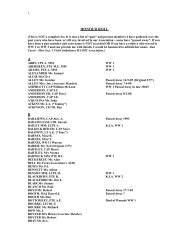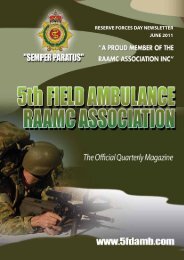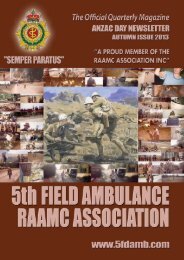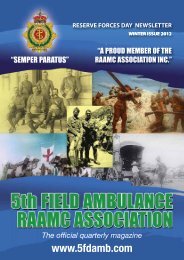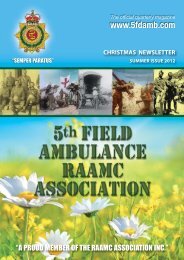2010 Paulatim Magazine - RAAMC Association
2010 Paulatim Magazine - RAAMC Association
2010 Paulatim Magazine - RAAMC Association
You also want an ePaper? Increase the reach of your titles
YUMPU automatically turns print PDFs into web optimized ePapers that Google loves.
The role of physiotherapy in war<br />
Physiotherapists have been serving with the Australian Defence Force<br />
(ADF) since 1915 when the first contingent of masseurs and masseuses<br />
left Australian shores to serve with the Australian Imperial Force (AIF)<br />
in Egypt. (Physiotherapy in war; H. C. Wilson; Gillingham Printers Pty<br />
Ltd 1995: pg 1).<br />
Masseuses had the rank of private, with the privileges of an officer<br />
rank but were not allowed to treat officers. Masseurs held<br />
commissioned rank. In 1915 masseuses & masseurs became part of the<br />
medical establishment and authority was given to establish an Army<br />
Massage Service, having an establishment of 6 honorary Lieutenant<br />
Masseurs who worked in the Command Posts and 48 Masseuses with<br />
the rank of Staff Nurse, who worked in the Auxiliary Hospitals in<br />
England. Interestingly, it was not until 1919 that the UK Army got a<br />
similar service.<br />
In 1915 the Director General of Medical Services (DGMS) recognised<br />
the valuable service that Masseur/ses could provide as he advised that<br />
ìjoint injuries can be set at once, provided they are transported on ships<br />
with facilities for massage Öî.Staff Sergeant Beck, a masseuse, wrote in<br />
1916 from Mena House in Egypt ìthere were plentiful supplies of<br />
injuries to knees, ankles, and lumbagoî. The range of treatment<br />
included massage and hot air baths to open wounds treated with zinc or<br />
copper ionization. (Physiotherapy in war; H. C. Wilson; Gillingham<br />
Printers Pty Ltd 1995).<br />
Much like the advancement of medicine through war, a wider concept of<br />
physical therapy emerged towards the end of WW1. This being the<br />
recognition and incorporation of remedial exercises aimed at the<br />
attainment of a functional result. From this concept, ìPhysiotherapyî<br />
and its philosophy in the restoration of movement and function through<br />
manual and exercise therapy were born.<br />
During WW2, there were several different treatment approaches that<br />
were developed. For burns saline baths were provided, whereby the<br />
physiotherapistís role was to prevent joint stiffness by graduated<br />
movements in the heated solutions. Numerous pinch grafts were<br />
applied, once taken the physiotherapist applied.Open wounds were<br />
initially treated using the closed procedure, which involved primary<br />
excision and enclosing in plaster until healing occurred. This caused<br />
very stiff joints which needed passive & active movement and remedial<br />
physiotherapist exercises. For orthopaedic injuries patients were moved<br />
to Cairo. From the initial onset, the physiotherapistís role has been two<br />
fold. To rehabilitate ADF members and return them to active duty, thus<br />
maintaining the fighting force in the Area of Operation (AO), and to<br />
rehabilitate ADF members who are required to leave the service<br />
through injury to facilitate their transition to civilian life.<br />
The Vietnam War demonstrated the need for a physiotherapist to be<br />
well forward in the battle space. Physiotherapist LT H. Skewes was the<br />
only physiotherapist deployed with the 1st Australian Field Hospital in<br />
Vung Tau and undertook chest care to soldiers in ICU following mine<br />
explosions; minor gun shot wounds or fragment wounds requiring short<br />
term rehabilitation. LT H. Skewes worked close to the fighting, so<br />
different to physiotherapists of WW1 and WW2 who were in the rear<br />
echelons.<br />
The work of physiotherapists has been no more aptly demonstrated<br />
than from my deployment with Special Operations Task Group (SOTG),<br />
Afghanistan. This presented a unique challenge where not only is the<br />
physiotherapist required to adapt to the environment to effectively<br />
apply techniques.<br />
SOTG members are highly specialised and physically fit. Muscularskeletal<br />
injuries whilst out side the wire (OTW) present as lower neck,<br />
mid back, rib, lower back, or shoulder strains, with the occasional ankle<br />
The before and after result of a localised Grade V manipulation to L4/5 to restore Lumbar extension.<br />
9 0 P A U L AT I M – M A GAZINE O F T HE R OYA L A U S T R A L I A N A R M Y M E DICAL C O R P S – 2 0 1 0



